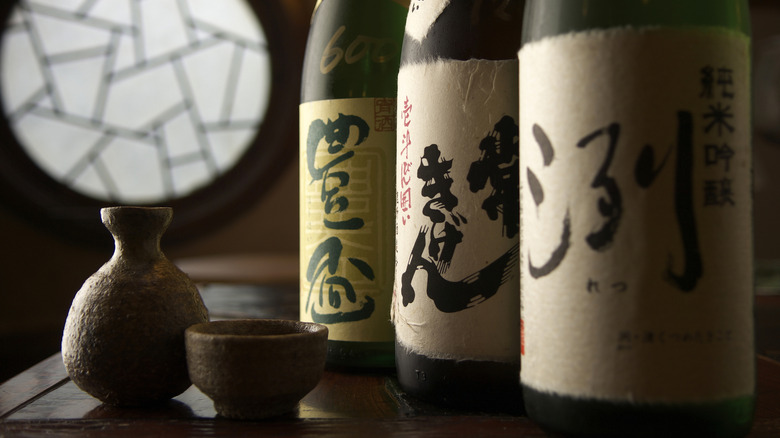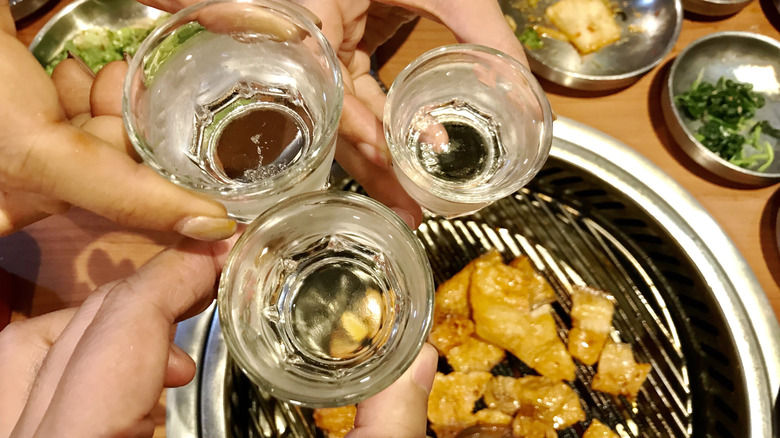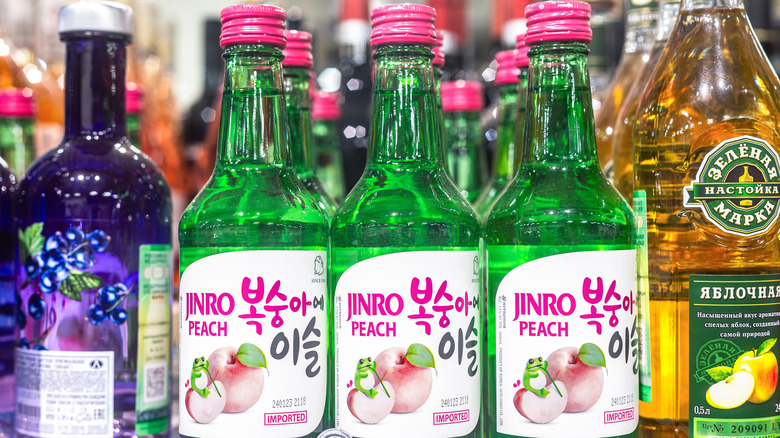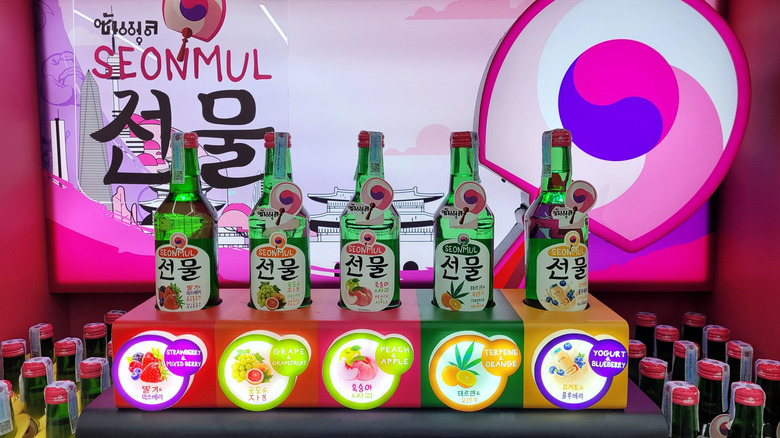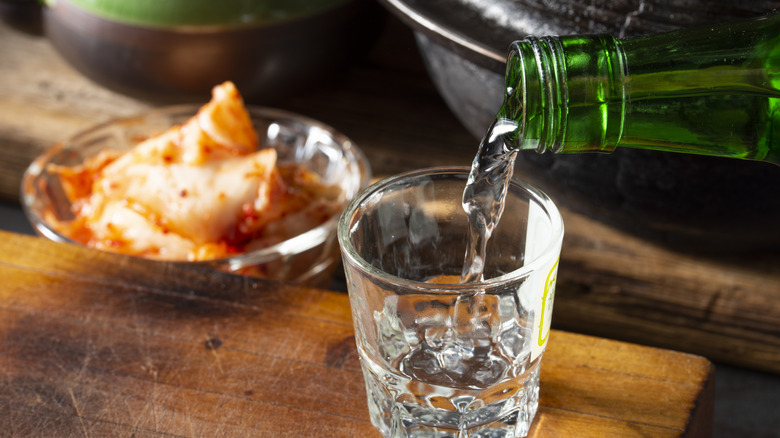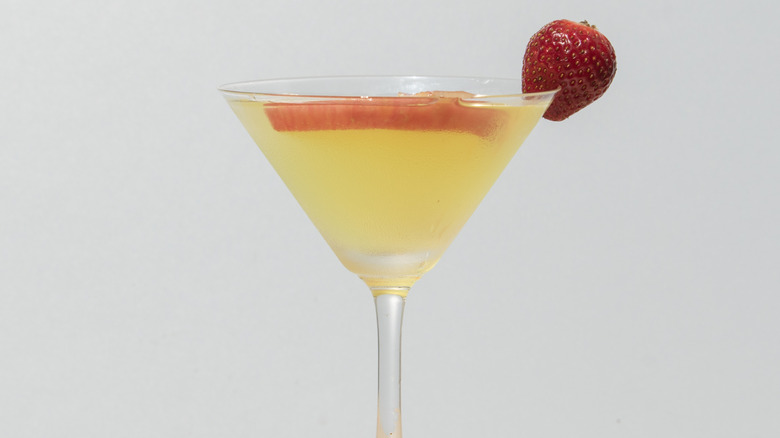What Is Soju And What Does It Taste Like?
Countries with celebrated food cultures very often boast equally celebrated drinks to complement their feasts — what would a French or Italian dinner be without a matching local wine, or a German feast without one of the country's famed beers? If you visit a busy Korean barbecue restaurant, you may notice a plethora of small green bottles being delivered to tables. There, you'll see happy diners pouring glasses of the clear drink for each other as they enjoy it with their meal.
This drink — now gaining popularity among American diners and drinkers — is soju, the national drink of Korea. And while it's a distilled spirit that translates as "burned liquor" in Korean, it's surprisingly easy to drink. It's far lower in alcohol than more familiar distilled spirits (its ABV hovers around 20%, about half that of whiskey), and its gently sweet flavor is more soothing than fiery.
Here to get you up to speed on this ancient yet trendy drink are Kevin Bryne, bartender at Genesis House Restaurant in New York City, Tenzing Palden, wine director and sommelier of HIS Hospitality Group in Chicago (overseeing Omakase Yume, Bonyeon, and TenGoku Aburiya), Seoyeon Harden, co-owner of Southside Super, a Korean/Vietnamese diner in Sacramento, California, and culinary consultant Bryan Quoc Le, founder of Mendocino Food Consulting.
What is soju?
The simplest way to describe soju is it's an alcoholic beverage distilled from grain — but once you taste it, you'll realize it's a far cry from more familiar Western spirits such as vodka or whiskey. Traditional soju is fermented from rice or barley, but some versions have a wheat or even sweet potato base. It's a bit sweet and less alcoholic than bold whiskeys and vodkas, which makes it a great match for food — in Korea, it's traditionally sipped with meals. "Soju is usually enjoyed with plenty of anju — dishes served specifically to complement alcohol," Seoyeon Harden explained. "Popular anju include soups, Korean pancakes, grilled pork belly, and Korean barbecue."
While soju has a long history in Korea, Bryan Quoc Le explained that the drink has ancestral roots in Persian and Mongolian cultures. "Distillation was first formally invented by the Persians in the early 8th century," he said. "When the Mongolians encountered the Persians, they took back with them the technique of distilling alcohol, which came to Korea in the 13th century after the Mongols invaded the peninsula." The Mongols eventually shifted from their original grape-based liquor recipe to a distillate made from rice, which was more easily available — and this drink evolved into today's soju.
How is soju made?
While Western spirits such as vodka and gin are simply fermented with yeast, then distilled, soju employs a more complex method, which contributes to its unique and distinctive flavor. Instead of yeast, the ferment for soju uses nuruk, which Kevin Bryne explained, "is a sort of Korean mother starter." To make nuruk, brewers steam barley until it's soft, pack it into bricks, and allow it to ferment with natural airborne yeasts and aspergillus oryzae, a fungus that releases amylase (an enzyme) as it digests the grain.
As Bryne explained, brewers break the nuruk bricks into flakes and mix them into a slurry of rice or barley — this mixture forms the base for the soju. Then, two distinct chemical processes take place simultaneously as soju develops. First, the amylase released by the fungus breaks down long chain carbohydrates into simple sugars. Second, wild yeasts that settle in the soju mixture feed on this sugar, which triggers the production of alcohol. Once the mixture has fermented, brewers strain it and distill it into soju. This unique technique has not only proven effective, but is part of what gives soju its uniquely appealing flavor.
Soju vs. sake
Soju's closest relative in the beverage world is its Japanese counterpart, sake. Both are made from rice (some of the time for soju, all of the time for sake), and both employ fungal cultures as part of their fermentation. Just as soju's fermentation is jump-started by nuruk, a culture of cooked barley, yeast, and beneficial fungus, sake's fermentation starts with koji, which is cooked rice inoculated with the same fungus. Unlike soju, however, sake does not undergo distillation following fermentation.
The two drinks can have similar flavor profiles, but they also have distinct differences. Sake is sweeter and thicker than soju, and tends to have more fruity notes. Soju is a bit dryer and more subdued. For this reason, sake and soju aren't interchangeable in recipes — if you have a recipe that calls for sake, use mirin rather than open a soju bottle. While soju can be made with a range of grains or other starches, sake can only be made from rice. However, sake can be just as varied as soju — five main types of traditional sake exist, each made with specific types of rice and their own proportions of sugar and yeast, giving them richly nuanced flavors.
What does soju taste like?
Traditionally, soju was considered the drinkable equivalent of a classic white tee shirt — dependable, neutral, and goes with anything. "Soju is produced in a way that is usually considered utilitarian, much like vodka," Kevin Bryne said. "It's only recently, with the craft brewing and distilling renaissance, that you find any significant variation upon the theme."
Typically, Bryan Quoc Le, explained, soju has a refreshing, sweet, clean flavor profile. And since it has less alcohol than vodka, it is also smoother. In addition, its flavor can vary depending on the grain used. "Unflavored soju carries hints of the original grain," Tenzing Palden said. Palden added that rice sojus tend to be more neutral in flavor, while wheat sojus are bolder and spicier.
In addition, you can find fruit-flavored soju varieties, as well as artisanal soju types with distinctive flavor profiles. Damsoul, Bryne explained, is a soju variety "infused with pine needles for a spirit reminiscent of gin," and "other [brands] like Samhae and Pungjeong Sagye's 'Winter' series show off a deeper almost resinous character you'd find in American white whiskeys or agave spirits."
How to serve soju
Traditionally, drinkers enjoy soju chilled and served in shot glasses — either downed as a single shot or sipped at leisure. But modern drinkers have embraced other ways to consume it. Some serve it over ice for a less concentrated drink, while fans of high-end, artisanal soju prefer to sip the drink in a wine glass at room temperature, a presentation that better showcases its unique flavors and aromas.
No matter how you like your soju, however, our experts emphasized that it's best enjoyed in the company of others. "It's deeply intertwined with social gatherings, whether among friends, family, or colleagues," Seoyoen Harden explained. If you find yourself at a gathering where soju is served, however, don't just grab the bottle and start pouring — there's a right and wrong way to do it.
"Should you choose to share a bottle at the table, there are traditional rules of etiquette, such as never pouring for yourself, which can be considered impolite," Kevin Bryne said. "The youngest at the table typically pours the first round, starting with the eldest or the highest-ranking guest if in a professional setting." In addition, he said, a very old tradition calls for younger guests to show deference to their elders by turning away and covering their mouths when drinking soju in their company.
Where to buy soju
With the growing popularity of soju in North America, it has become increasingly easy to find. Chances are, you'll be able to buy it in all the places you usually go for beer and wine, such as major supermarkets or liquor stores like Total Wine & More. And if you were planning on serving soju with a home-cooked Korean meal, you can probably find a few types at the Asian grocery store when you shop for your dinner ingredients. Moreover, you'll likely be able to choose from a variety of soju flavors and types. Since most mass-market bottles are inexpensive and on the small side (around 12 ounces, or half a wine bottle), it's easy to pick up a couple of different flavors to see which you and your friends like best.
If you're interested in trying some of the higher-end varieties of artisanal soju, however, you might have to look a bit harder. For instance, Samhae Soju is so respected that the brewery was declared part of Seoul's "intangible cultural heritage." Because it's hand crafted, it's pricey and must be acquired through a specialty retailer. But if you want to try soju without committing to a whole bottle, seek out a good craft cocktail bar — many of them now carry a variety, both for sipping and for mixing in cocktails.
Nutritional value of soju
Soju is a beloved part of Korean culture and has long been a highlight of celebratory meals and social gatherings. Perhaps because it's a part of so many happy events, it has gained a reputation as a wholesome, beneficial drink. Traditionally, it's thought to aid digestion, which is why it's the drink of choice at feasts featuring lots of rich, spicy food. Some drinkers also believe that a daily dose of soju is good for their health, while others claim you can drink it freely and never get a hangover.
The cold, hard numbers tell a different story. Although alcoholic drinks (in moderation) can lower stress and induce a feeling of well-being, you're not going to get much in the way of nutrients from your shot. Soju may be fat-free, but it's also free of most other nutrients, apart from carbs — soju is about 93% carbs and 7% protein, with 45 calories in a 1-ounce shot. And sorry, the myth isn't true — drinking too much soju, like drinking too much of any booze, can indeed give you a hangover. So if you're looking for nutrients, be sure to order plenty of real food to accompany your soju.
Types of soju
Traditionally, soju was a neutral spirit appreciated for its mild flavor and ability to complement any meal. But because soju can be made with different grains, even these traditional options vary slightly in flavor and character depending on the base grain or starch, which can be rice, wheat, barley, tapioca, or sweet potatoes. Rice-based soju, for instance, is naturally sweeter compared with wheat or barley. Mass-market varieties made from cheaper ingredients such as sweet potatoes may contain added sweeteners to replicate the flavor of rice soju.
If you want something other than a plain neutral spirit to enjoy with your meal, you can easily find fruit-flavored soju. As Tenzing Palden explains, these get an addition of fruit flavoring after distillation. Flavors can include everything from strawberry, grape, and grapefruit to tropical fruits such as passion fruit and pineapple. In recent years, according to Kevin Bryne, craft distillers have started to create distinctive new soju varieties by reviving or refining traditional distillation methods or employing new and better ingredients. "With higher quality component products, there has been a new movement to show off individual character and to differentiate one style from another in the market," he described.
How to store soju
Perhaps one of the reasons for soju's popularity is it doesn't need coddling. "Soju is a spirit. So, it's not seriously negatively affected by its storage conditions," Kevin Bryne explained, adding, "It is best stored in a cool dark room, but it does not require special temperature controls to maintain quality." This means it's easy for busy restaurants and bars (and for that matter, home mixologists) to keep it on hand, even if climatized storage is unavailable.
You can keep sealed bottles of soju around for a while, but they're not meant to last forever. Extreme conditions in your kitchen or bar can also compromise the quality. Bryne noted that in theory, an unopened bottle of soju can be stored indefinitely, but this isn't a great idea — it can lose its flavor or smoothness over time. In addition, he added, harsh temperature or light conditions can compromise their flavors. Even though sealed bottles of soju are reasonably shelf-stable, once you open a bottle, plan to finish it quickly. "Opened soju should be consumed within the first week after opening and stored in the refrigerator," he said. "As opened soju ages, it might become harsher with a more pronounced burn."
Soju was once reserved for royalty
Today, soju is celebrated as a drink of the people. Drinkers enjoy it everywhere from working-class pubs to formal business dinners and family gatherings. Even in the U.S., inexpensive traditional green soju bottles are a familiar sight at liquor stores and Asian food markets. But back in soju's early days, the now-popular beverage was a rare treat reserved for nobility. "Soju became steeped in the Korean aristocracy as only they were able to afford the complex process of distillation," Bryan Quoc Le explained. "But over time, soju became a staple for Koreans of all classes." At this point, drinkers enjoyed the drink much as they do now — in pubs and inns, with hearty food to soak it up.
Later, however, the threat of food shortages changed its ubiquity. "During the Joseon era, soju was banned from being served to anyone other than the ruling class," Le explained. But this didn't stop working-class soju lovers from getting their fix. "Soju production went underground and was often home-brewed by the women of the households," he said.
Soju is great in cocktails
In Korea, drinkers not only enjoy soju straight, but as part of mixed drinks too. "Classic soju mixed drinks include so-maek, a popular combination of soju and beer," Seoyeon Harden explained. "Serious so-maek enthusiasts often have their own preferred ratios and mixing methods." Another popular choice, Harden added, is soju mixed with Yakult (a sweet, yogurt-based drink).
Meanwhile, creative mixologists outside of Korea have discovered that soju's gentle flavor makes it a versatile base for cocktails. For those new to it, Kevin Bryne recommends a soju highball with three parts soju to five parts soda water, and a twist of lemon. "This is the best way to interact with a craft spirit you might find unfamiliar, since the carbonation provides a bit of lift to the aromatics in the distillate, freeing them up and making them easier to identify," he explained.
In addition, his bar features soju drinks inspired by global cocktail traditions. A favorite, for example, is the Soju Vesper, which features soju, Damsoul, and Lillet Blanc served up with a twist. Bryne also gives soju a Mexican- inspired makeover with his High Line Sunset, which features soju, reposado tequila, honey, Contratto, and ginger, served in a glass with a tajín rim. Meanwhile Harden likes to use soju as a novel dessert drink. "A fun and refreshing cocktail is made by dipping a Melona ice cream bar into a glass of soju," he described.



